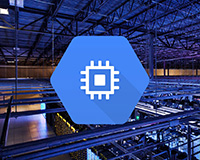
 With yesterday’s announcement about the general availability of its Compute Engine, Google has rounded its service-rich computing Cloud Platform into a full-on competitor to the elite and powerful handful of existing providers.
With yesterday’s announcement about the general availability of its Compute Engine, Google has rounded its service-rich computing Cloud Platform into a full-on competitor to the elite and powerful handful of existing providers.
Behind every notable online service or app, from Netflix to Angry Birds to Snapchat, is that set of backend processes requiring gobs (mega-gobs, peta-gobs) of digital storage and computing power. Until relatively recently, this required a tech startup to quickly come up with millions of dollars to build and test the systems that could accommodate growing user demand.
Amazon, having invested their tremendous resources to support their own retail enterprise, was the first to turn that infrastructure into a publicly available, cloud-based set of products and services. While they remain the biggest provider, other players have entered the field, including Microsoft and IBM.
With yesterday’s release, Google has lowered the price of some services and are probably playing to their strengths by exceeding the industry’s benchmark performance guarantees (“Monthly Uptime Percentage to Customer of at least 99.95%,” according to the Google Compute Engine Service Level Agreement). One way they plan to keep their promises is with their new, built-in live-migration technology: interruptions owing to scheduled maintenance will never happen.
Tech watchers insist that the offering hasn’t completely arrived, due in part to the need for better integration between the different products. Still, with their deep pockets, as well as the equipment and experience they’ve amassed to deliver their pervasive and heavily-used email, search and video services, the potential is very promising.
Google’s Cloud Platform could give its competitors a run for their money, sparking more innovation as they vie for the market. And while the number of companies offering cloud computing services isn’t likely to ever get very big, having one more solid option is welcome news.
For a more indepth look at Google’s entry into the cloud computing industry, see Quentin Hardy’s great piece in the New York Times. Check out the Google Cloud Platform blog for a detailed post about the Compute Engine General Availability status and features.
Do you use Amazon's cloud service? Would you consider switching to Google? Let us know your thoughts in the comments.
















